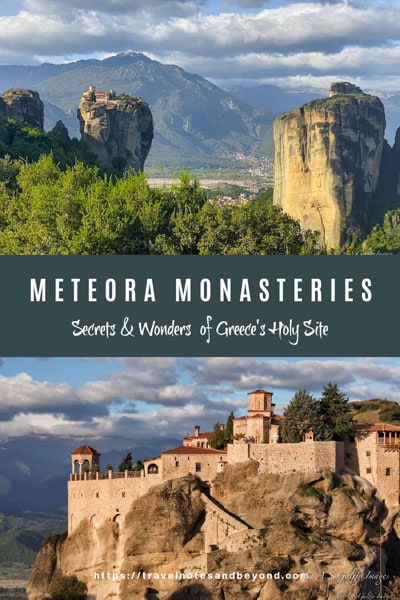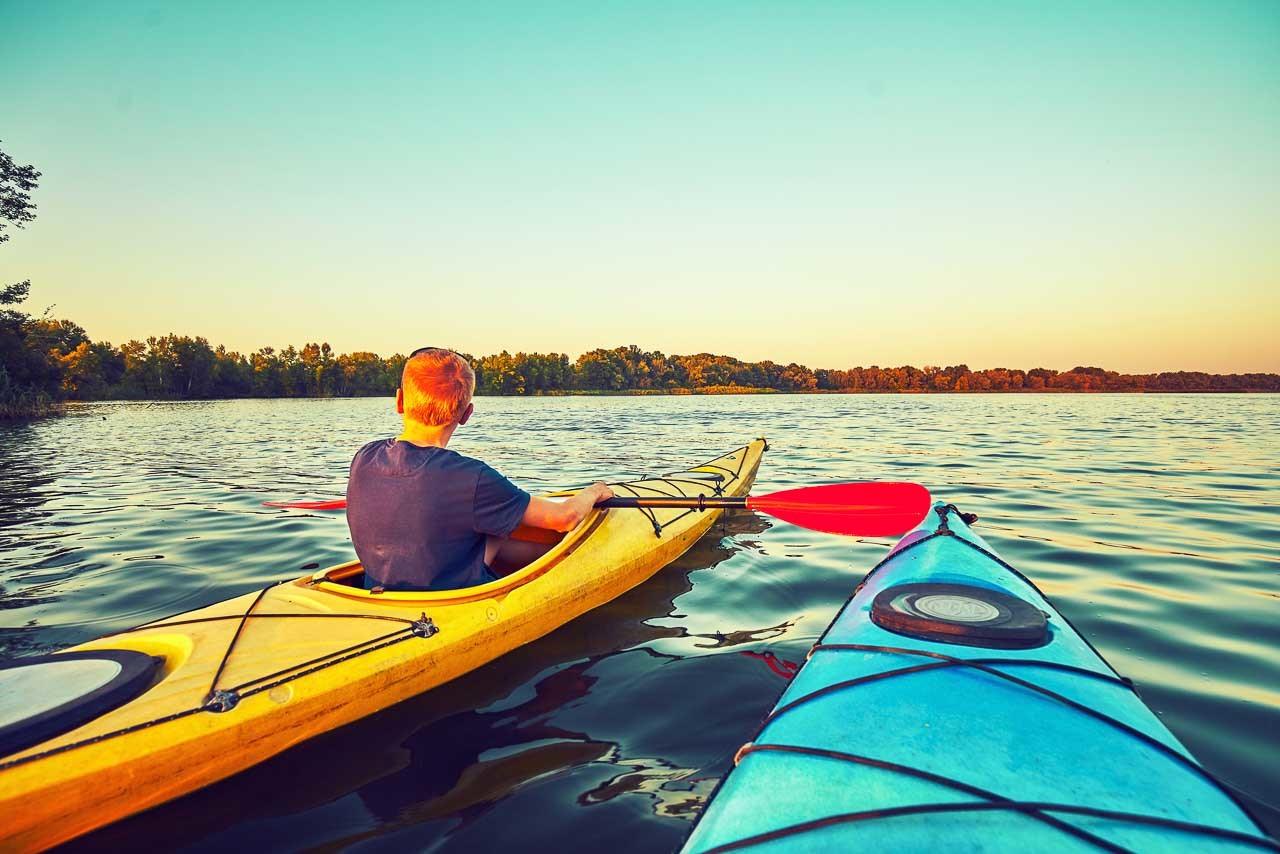Meteora Monasteries – Journey Into the Sacred Site of Greece
17 min read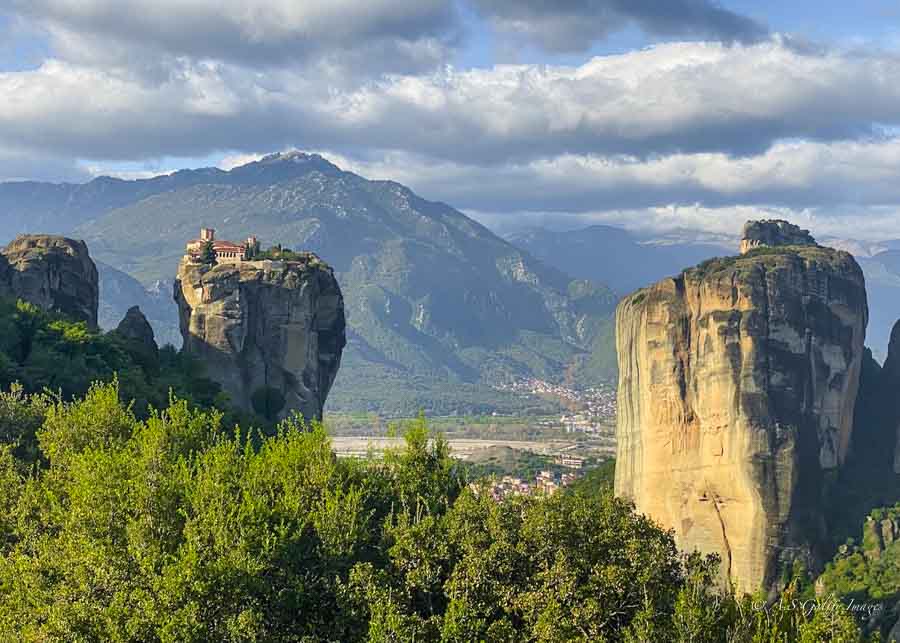
Table of Contents
Only a few hours from Athens, in the Valley of Thessaly near the town of Kalambaka, lies one of Greece’s most astonishing religious sites: the Monasteries of Meteora! Second in importance only to Mount Athos, this UNESCO World Heritage site is one of the most unusually built monastic complexes in the Eastern Orthodox Church.
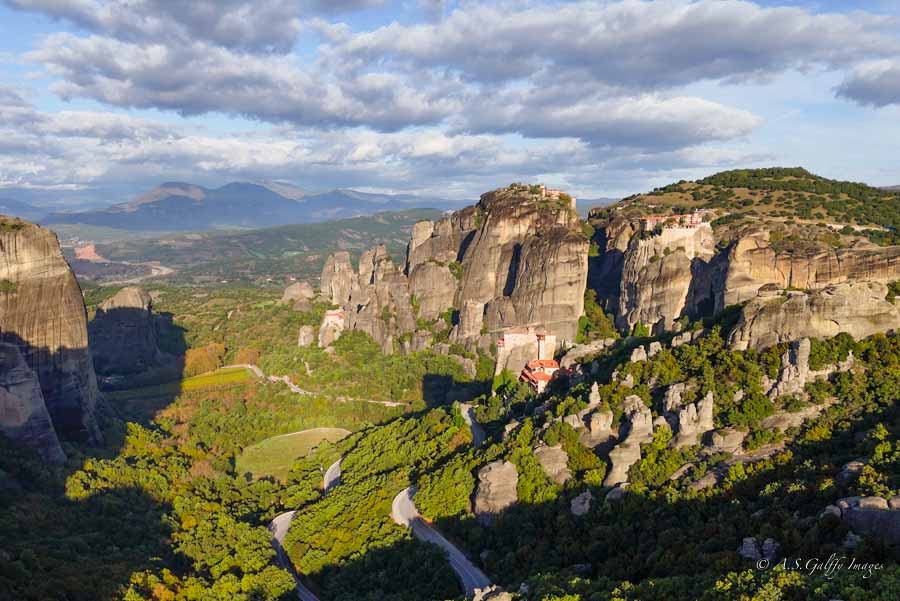
Whether you visit Meteora for religious reasons or simply because you like to travel, the monasteries will leave a long lasting impression on your heart. So join us as we uncover the wonders of this extraordinary place.
What Makes Meteora Special?
The Rock Formations
The utter immensity of Meteora’s towering rocks gives you a sense of grandeur that is hard to put into words. As you wind your way up through narrow paths or climb steep steps carved into rocks, you will feel a sense of adventure and anticipation. This mystical landscape has an atmosphere that feels almost surreal and gives you a sense of peace and tranquility.
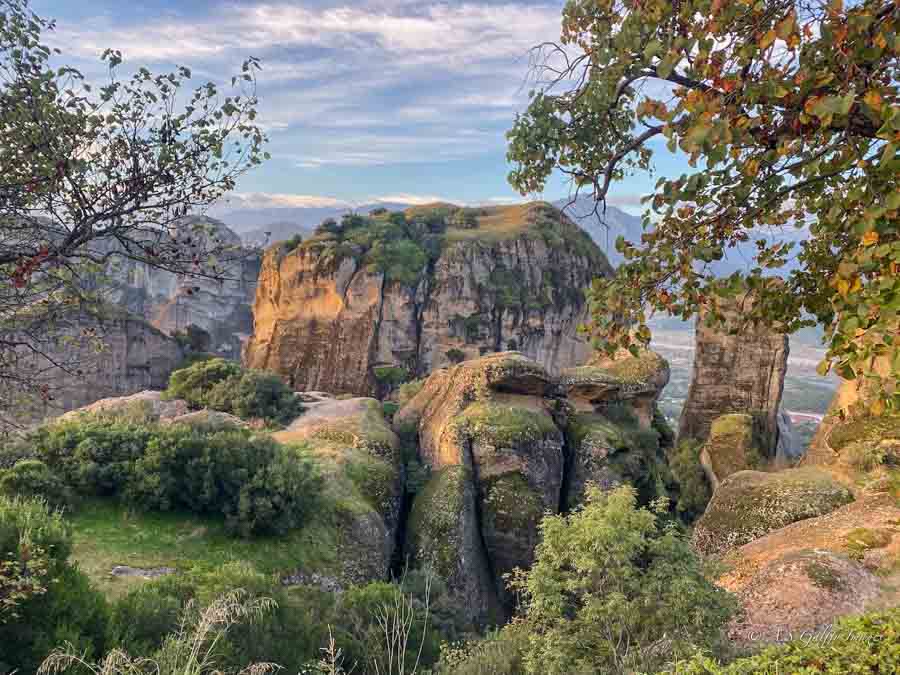
From a geological standpoint, Meteora is the result of earthly movements that must have occurred ages ago. But no matter its origin, the landscape you see today is a feast for the eyes! For wherever you look, you will be enchanted by the sweeping views of the valleys below and the distant mountains that stretch out as far as the eye can see.
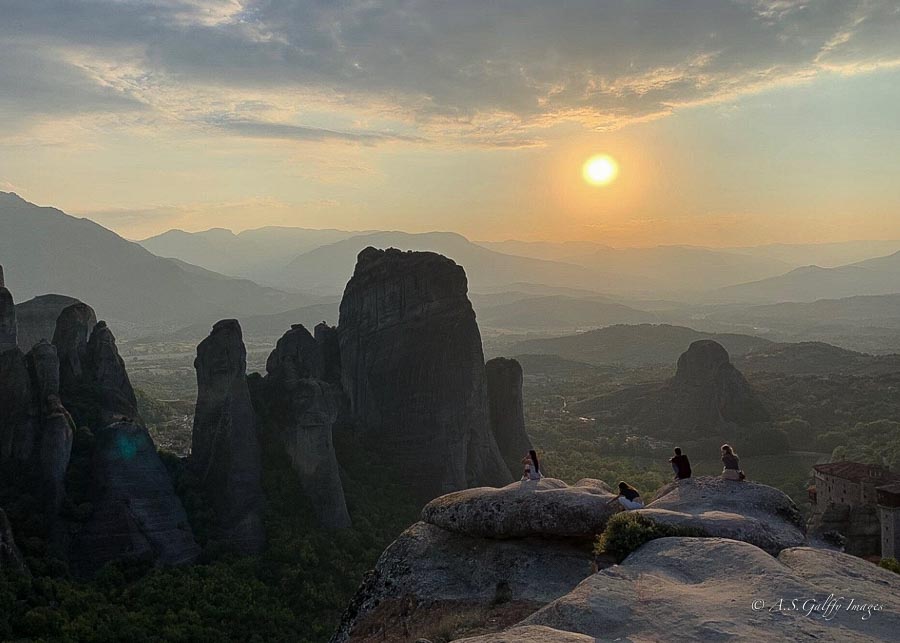
The ‘Monasteries in the Clouds’
But even more amazing than the rocks of Meteora are the six monasteries perched on top of them. Clinging precariously to their rocky pedestals, these structures seem to be floating up in the air, almost defying gravity. The name itself –Meteora– (meaning “suspended in the air”) perfectly describes the monasteries’ strange allure.

They seem to have been placed on these rocks by a divine hand, as it is indeed hard to believe that a mere handful of monks could have built such wonders. Yet they did! And therefore, the Monasteries of Meteora serve not only as sacred places of worship, but also as living testaments to human tenacity and determination.
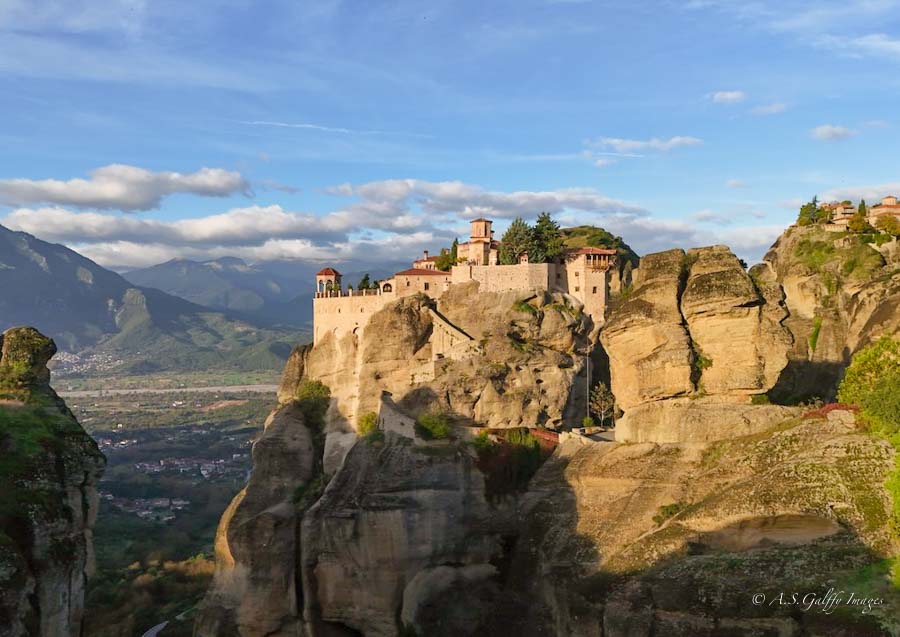
Beyond their architectural value, these monasteries hold invaluable treasures within their walls. Like intricate frescoes, wooden icons, old codices, manuscripts, and precious relics. Stepping inside one of these holy sanctuaries offers a glimpse into Byzantine history and spirituality.
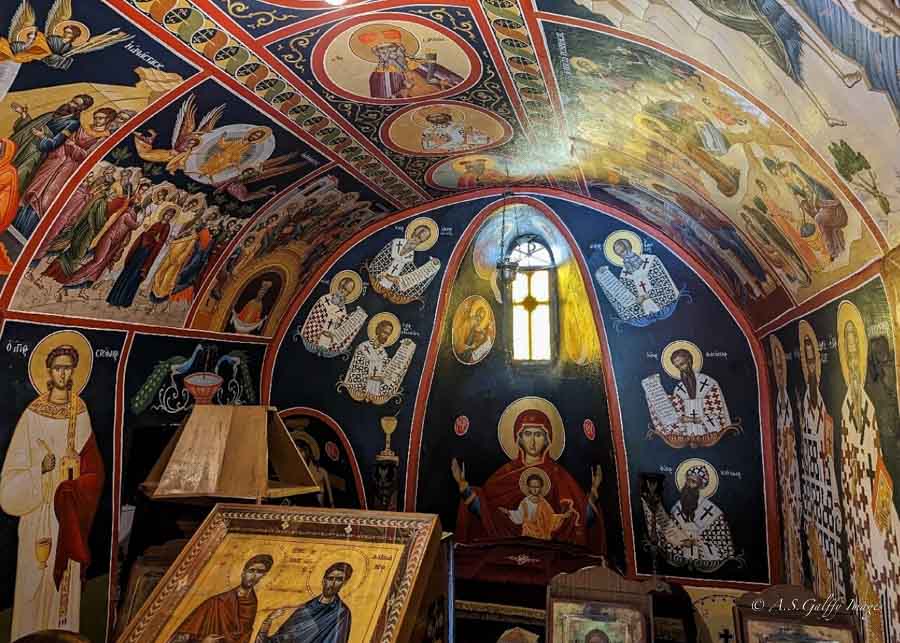
The History of Meteora Monasteries
Religious life in Meteora can be traced back to about 1000 AD, when hermits seeking solitude found refuge in the natural caves of these rocks. The hermits believed that by spending their life in prayer and meditation they will achieve a closer connection with God. Therefore they never climbed down from the caves. So how did they survive?
The Christians in the nearby village of Kastraki thought of these hermits as living saints, as mediators between them and God. So they used to approach the base of the rock to offer them food and water. The hermits pulled up the food with baskets and ropes and this is how they survived for centuries.
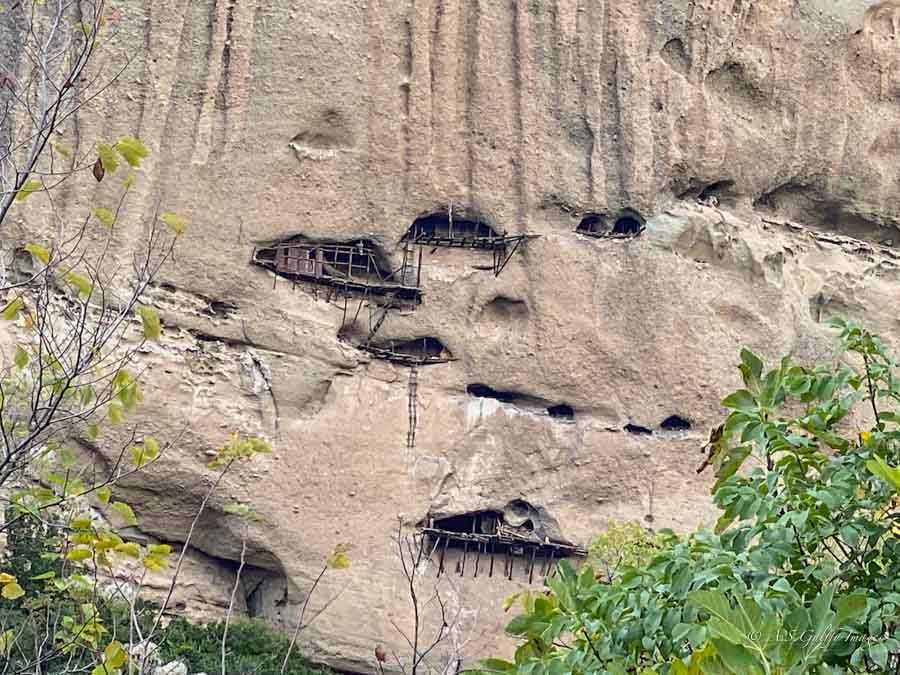
Traces of the hermit caves are still visible today near the village of Kastraki, between two large rock formations named Pyxari and Amparia. The locals call this area Badovas, hence the name – the Caves of Badovas. Old wooden ladders and other scaffolds from those times still remain perched high up on the cliff.
From Solitary Life to Organized Religion
Around the year 1160 AD, the next generation of hermits decided to build a small chapel under one of the rocks of Meteora. Every Sunday morning they used to climb down from their caves to have a common service and a common meal.
As they organized their first monastic community, the hermits elected spiritual leaders who established laws and traditions. There was also a common weekly schedule that every hermit had to follow. This marked the first phase of an organized monastic life in Meteora, which took place two centuries before the arrival of the first monks.
The First Monks Arrive in Meteora
The first monks arrived in Meteora at the beginning of the 14th century from Mount Athos, the oldest, largest and most important monastic community in Greece. But unlike the hermits who came strictly for spiritual reasons, the monks came to Meteora for practical reasons: to stay alive. They were running from the Ottoman persecution and also not to get affected by civil wars and uprisings in the Byzantine Empire, which was about to collapse.
As they arrived in Meteora, the monks began building small monasteries within the caves of the rocky walls. Two great examples of such monasteries can be seen today in the valley of Panaghia, next to the Hermit Caves.
One is the hermitage of Agios Antonios of Badovas, which was partially built inside a large cavity. In the old days, this small abbey was accessible only through a cave that existed right below it. Only one single monk lives here today, and he is 94 years old!
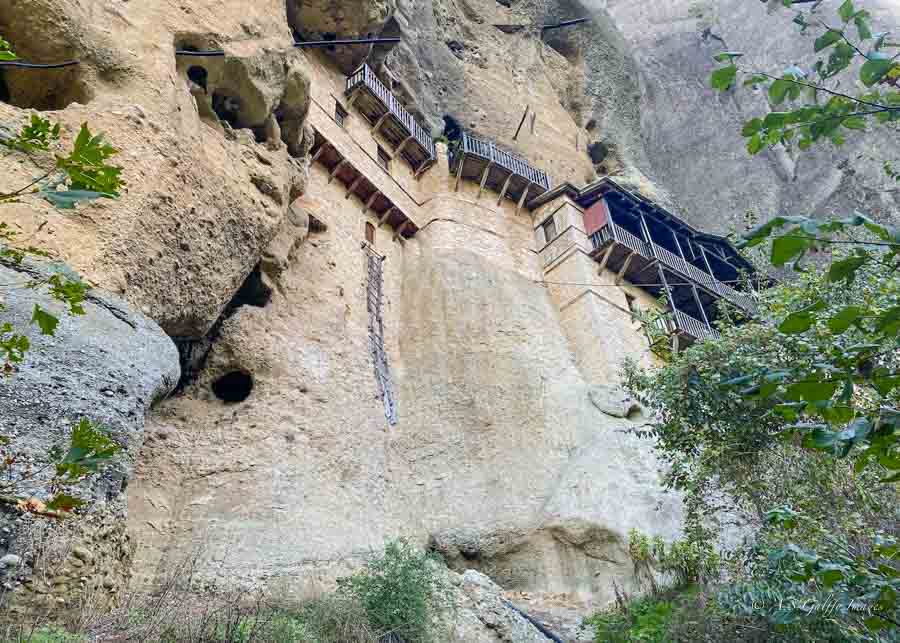
The other is the nearby small monastery of Agios Nikolaos of Badovas, which dates back to the 14th century. The monastery, which is today abandoned, was built into a natural cavity existing on the side of a cliff.
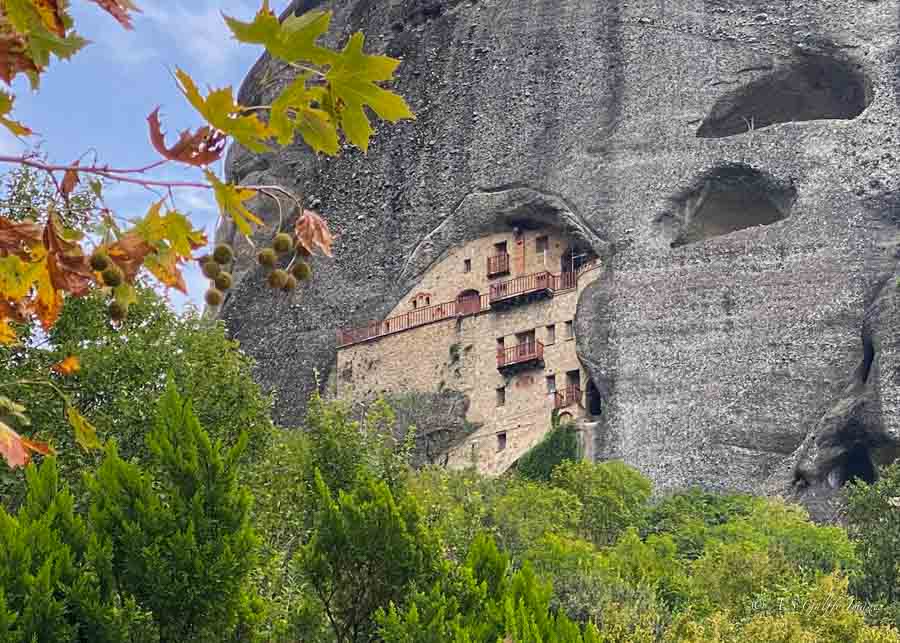
These two monasteries as well as the Hermit Caves are not on the route of the tour busses, so make sure you add them to your list if you visit Meteora on your own.
When you look at the angle of these old constructions, you can’t help but wonder how did the monks mage to build them on such inaccessible sandstone peaks?
The Building of the Monasteries in Meteora
Building the monasteries of Meteora was a long and difficult process. Sometimes more than two different generations of monks worked for 80-90 years, and yet never lived to see the monastery completed!
With no climbing experience, the first monks had to find a way to climb these stone walls. So they started by digging small holes in the rock with a nail and a chisel. For a short period they would pour white vinegar in the small holes. As white vinegar is acidic and causes an artificial erosion in the limestone rock, the holes became larger. This made it easier to start fixing wooden platforms that will help them reach the top of the rock.
But once they reached the top, the monks had to solve another problem: water. So they began carving the rock in order to make artificial wells where they would collect the rain water. In order to preserve it for longer periods, the monks would store the water in huge barrels and add lemon to it, to keep it from spoiling.
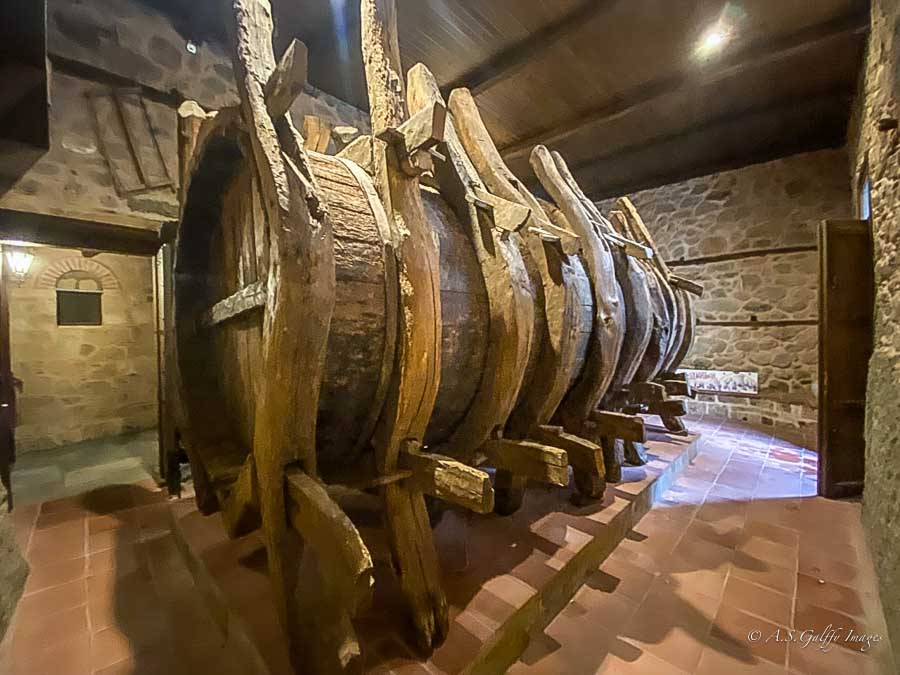
The building process was also very difficult. The monks had to gather wood, stone and other building materials and hoist them to the top of the rocks. Even though they had the will and determination to sacrifice their life in order to gather building materials, they didn’t have the skills to build the monasteries themselves. So for that task they hired local builders.
The first monastery was built in 1340. But Meteora reached its prime between the 15th and 17th century, with the arrival of many monks from other monasteries. After the 17th century its prosperity began to fade away. Raids of thieves and conquerors caused the destruction and abandonment of many monasteries.
6 Awe-Inspiring Monasteries to Visit in Meteora
Today, only six monasteries remain in operation out of the twenty-four initially built. Four of the six active monasteries are run by monks and only two (Agios Stefanos & Roussanou) are convents with nuns. Even so, there are approximately 50 nuns and only 18 monks living in the monasteries of Meteora today.
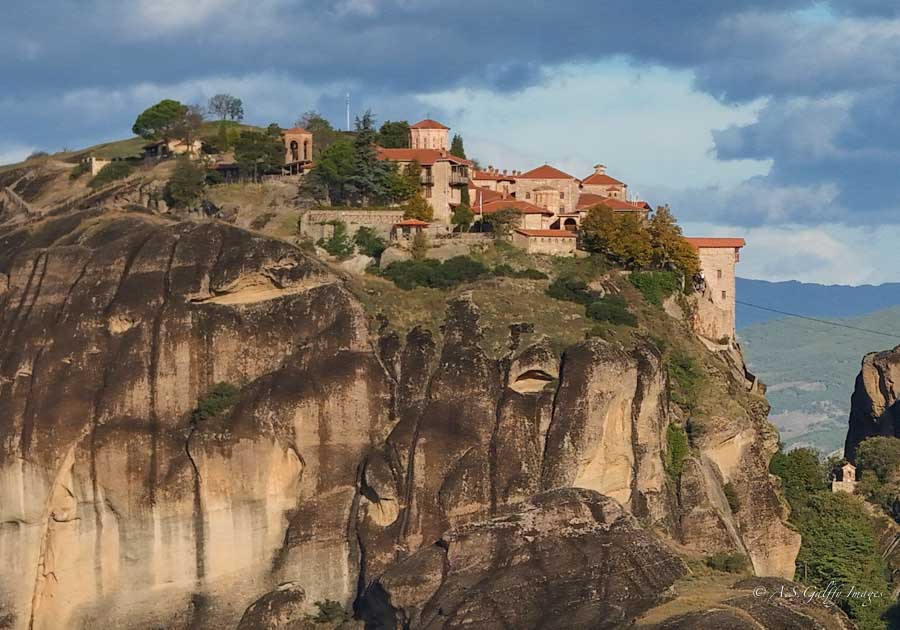
Great Meteoron Monastery
Perched on the highest rock in Meteora, the Great Meteoron Monastery is the oldest and most imposing of all the monasteries. The abbey was founded in the first part of the 14th Century by Saint Athanasios, the Meteorite. Together with 14 other monks, he carved out holes in the cliff, raised scaffolding and managed to raise a monastery around 1340 AD. He organized the first systematic monastic community in Meteora.
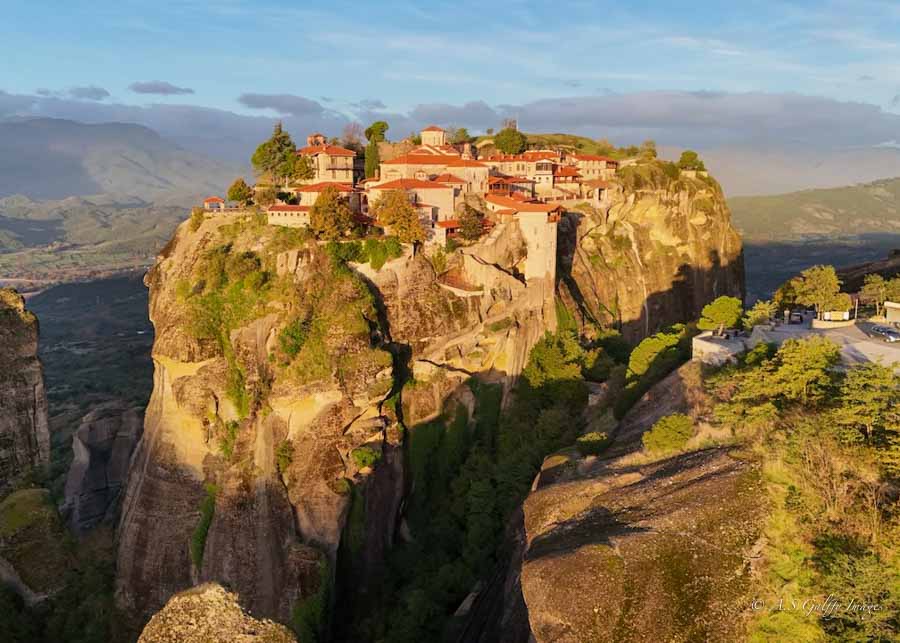
In the past, the only access to the monastery was through rope ladders. Then, in the year 1520, the monks created a system with a net at its end that they use even today for some tasks.
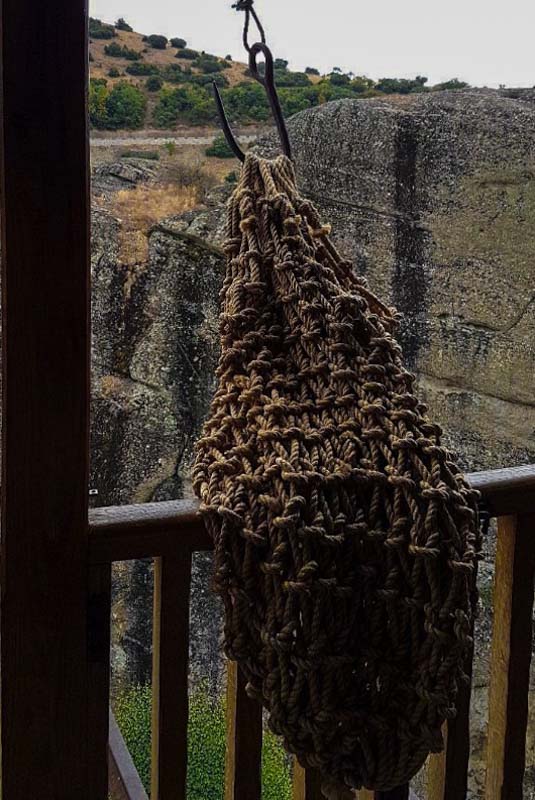
From the 1920s the ascent is through a narrow staircase that spirals all the way to the entrance of the monastery.
The monastery created several beautiful museums for the presentation of its valuable religious treasures. Here you can admire some outstanding wood icons, gold-embroideries, manuscripts, codices, incunabula, and liturgical utensils.
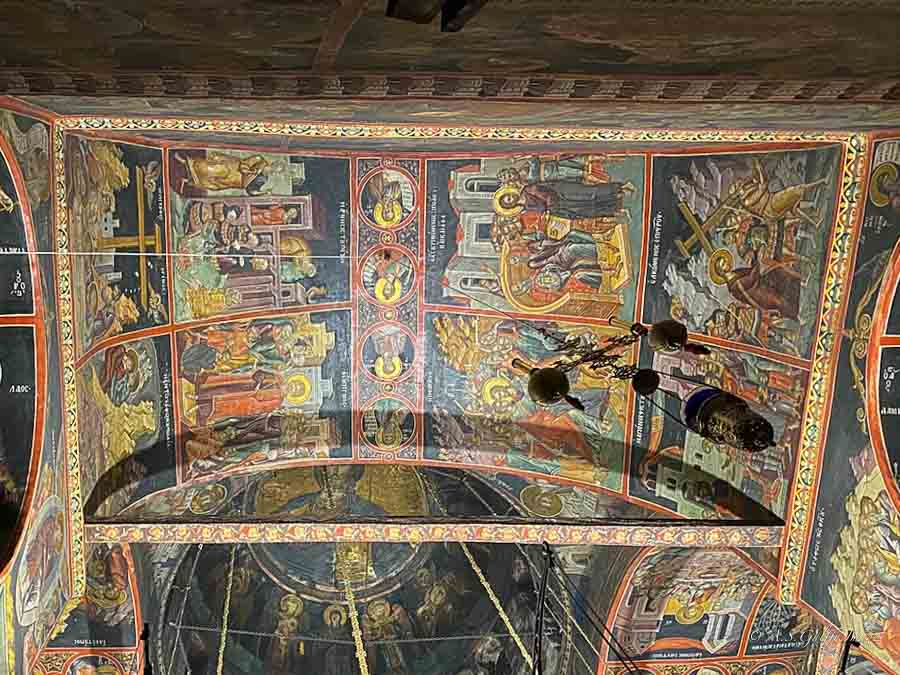
In the narthex and the chapel are some remarkable frescos that have been attributed to a student of Theophanes the Cretan (also known as El Greco). The Great Meteoron is more of a museum than a monastery, although they say it’s an active convent.
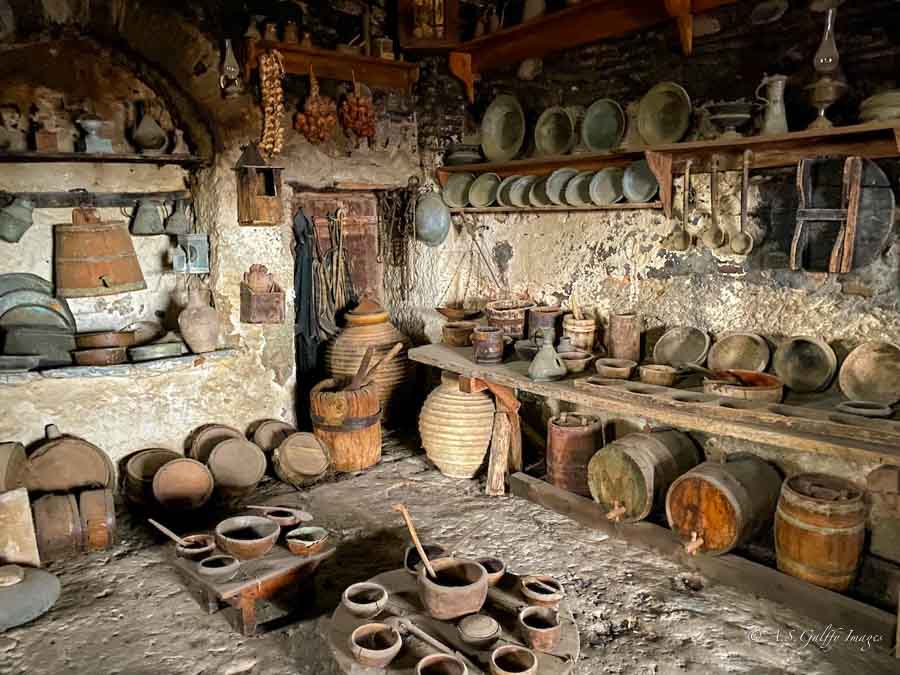
This is one of the most difficult monasteries to visit in Meteora. There are over 300 steps to climb to the entry, so it might not be suitable for people with mobility issues.
Varlaam Monastery
Perhaps the most beautiful monastery you’ll visit in Meteora is Varlaam, which is a male monastery. It is also the second largest one, after the Great Meteoron. The monastery was named after its founder – the austere monk Varlaam – who lived in a cave as a hermit and built a small chapel on top of this rock.
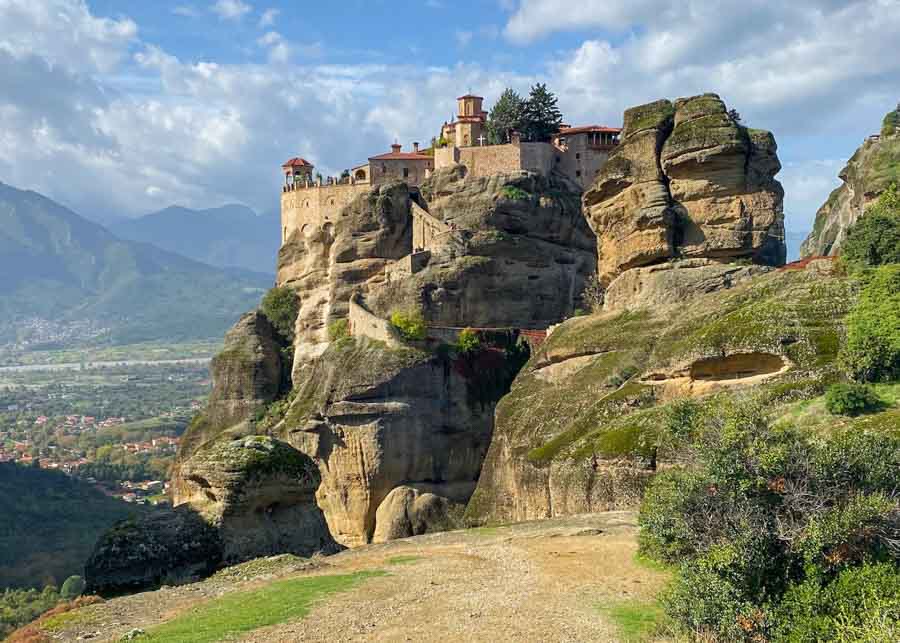
In the 16th century, two brothers, Theophanis and Nektarios Apsaradas who were both monks, enlarged the chapel built by Varlaam and built a monastery. Therefore, they are celebrated today as the two founders of the monastery of Varlaam.
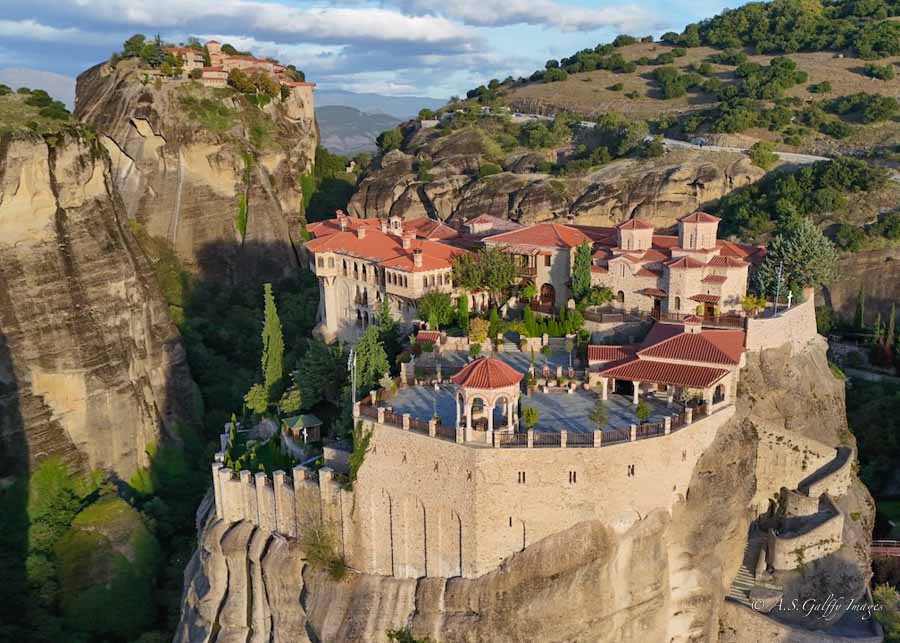
The monastery was decorated in 1548 by Frangos Kastellanos, an important Byzantine iconographer, who painted some beautiful frescoes in the church of Agioi Pantes. To the north side there is another church which was built much later, in 1627. This is known as the Chapel of the Three, and has a square-shaped cross on the roof.
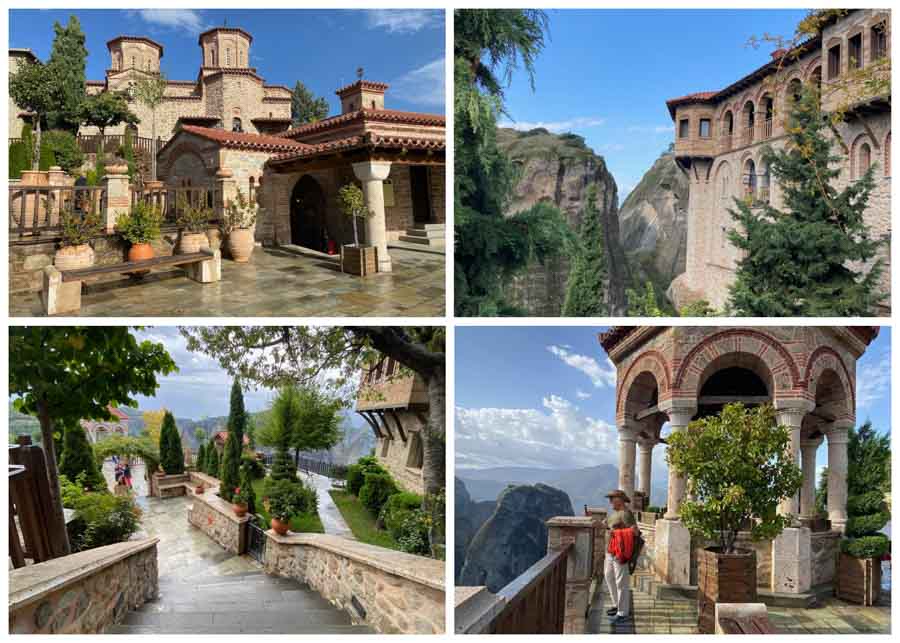
Varlaam Monastery has beautiful gardens and terraces that offer exceptional views of the valley below. There is also a beautiful museum where they exhibit many of the monastery’s valuable relics, art, and manuscripts.
The male monastery of Varlaam can be accessed through a small bridge from the main road, but there are 195 steps carved in the rock to climb.
Holy Monastery of Roussanou in Meteora
Opposite the Monastery of Varlaam, towards the south, lies one of the two female convents in Meteora: the Roussanou. The monastery, which is dedicated to St Barbara, was built on a vertical pillar that rises 60 meters high above the ground and covers the entire surface of the rock (about 500 m2).
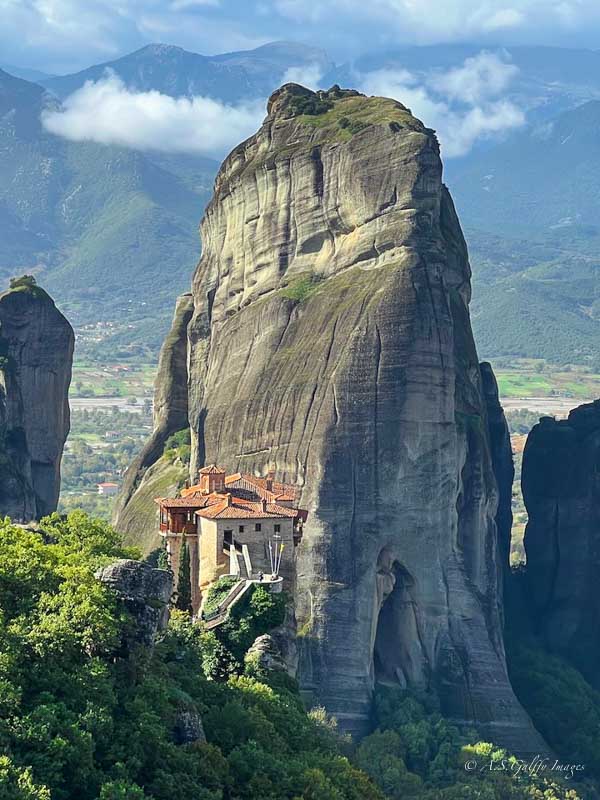
Initially founded by monks, the monastery became a convent relatively recently (in 1988) and today more than 15 sister nuns live there. Because the space is really small, the monastery was built on two levels. At the bottom of the rock are the nuns’ headquarters, surrounded by a beautiful garden, which is private.
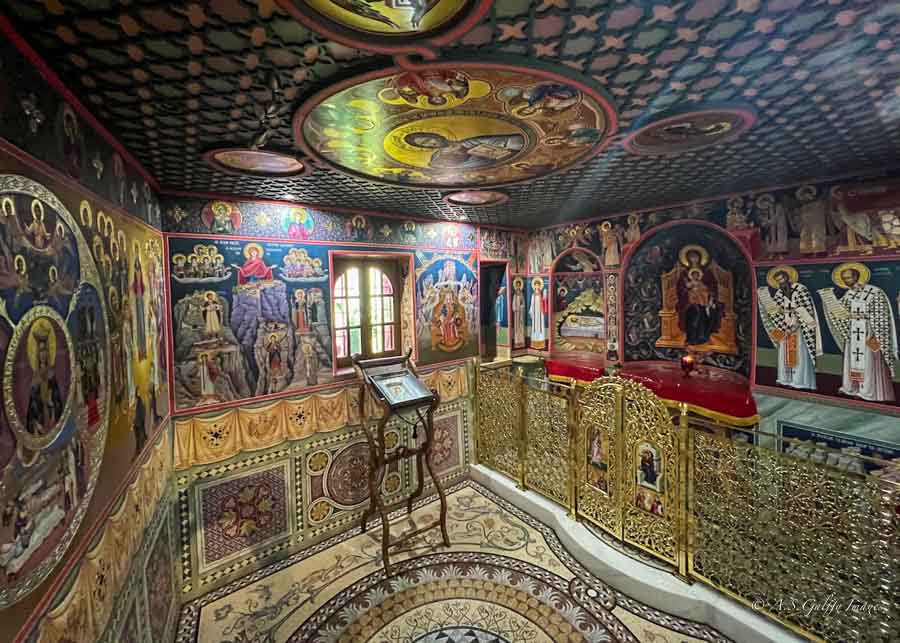
From the small terrace at the top of Roussanou you can see the ruins of the monastery of Pantokrator St. John the Baptist.
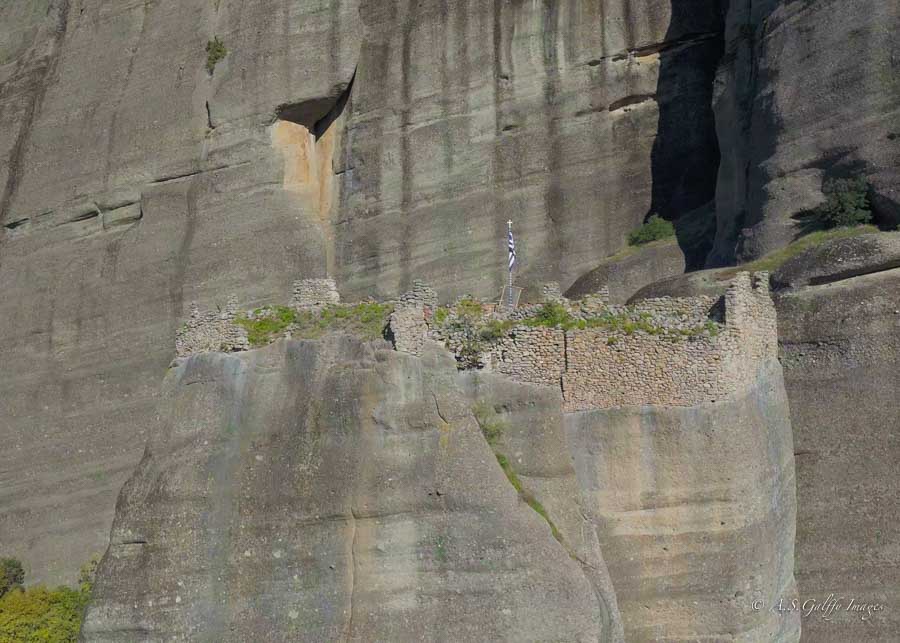
Agios Stefanos Monastery
The second convent with nuns in Meteora is Agios Stefanos. The first church ever built on this site dates back to the beginning of the 12th century, when the first hermit monks settled on the cliff. The present church is the result of a big reconstruction that took place during the second part of the 15th century and the beginning of 16th century.
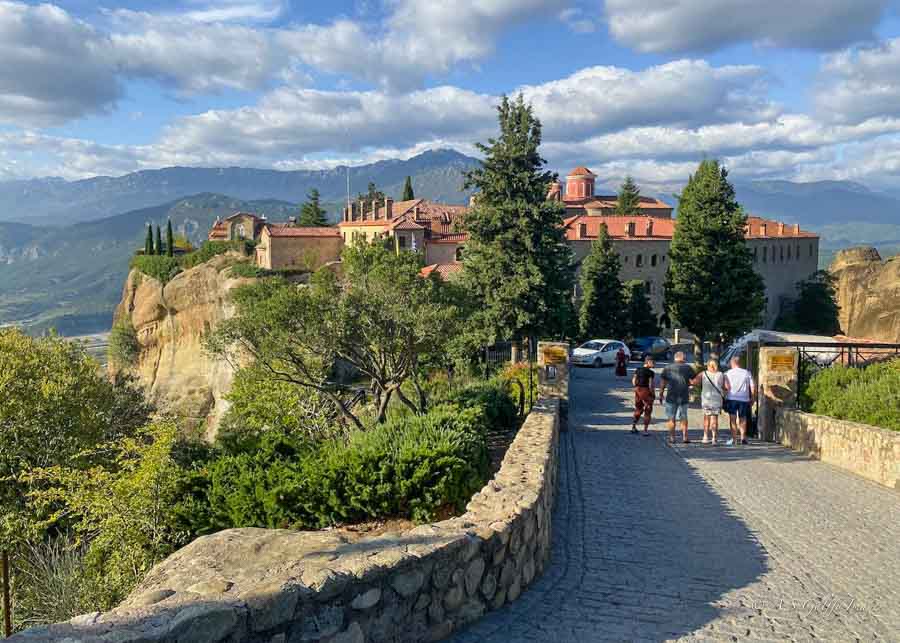
The monastery is pretty big and quite beautiful. It includes gardens and terraces and two outstanding cathedrals. One from the 16th-century which is smaller, and one from the 18th century which is dedicated to Agios Charalambos and includes the saint’s holy relics.
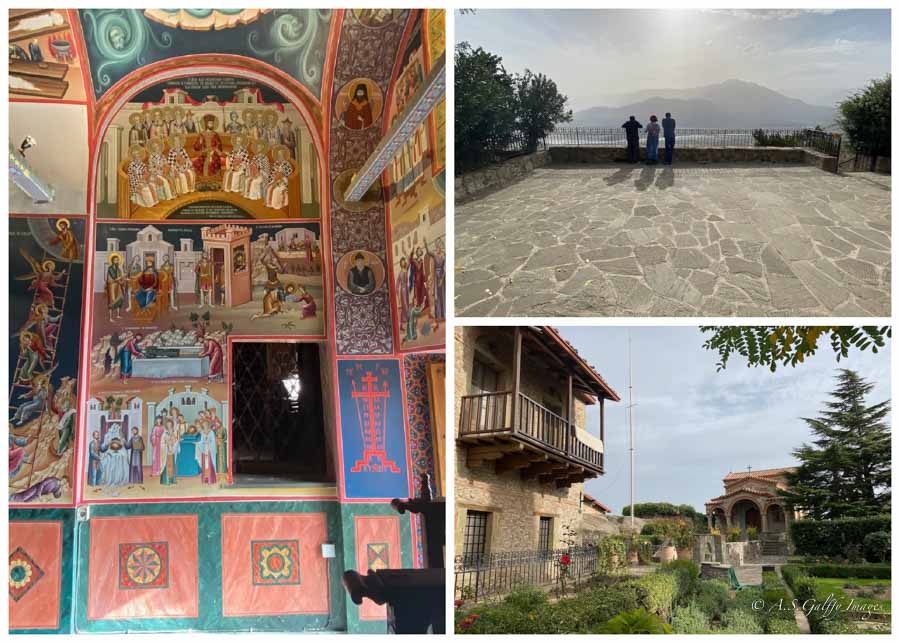
Of all the Monasteries of Meteora, Agios Stefanos is the only one that has an easy access. It is therefore ideal for people with mobility issues. Instead of steps carved in the rock, access is provided through a bridge that starts next to the main road.
Holy Trinity Monastery in Meteora
The Monastery of the Holy Trinity is perhaps the most famous of all the Greek monasteries in Meteora. And it’s not for religious or architectural reasons, but rather for being the filming location of the James Bond movie ‘For Your Eyes Only’ starring Roger Moore. Until watching the James Bond movie, not many people outside of Greece knew about this curious “monasteries in the sky.” But after seeing Bond ascending the rock cliff followed by the KGB, everybody became intrigued by this site.
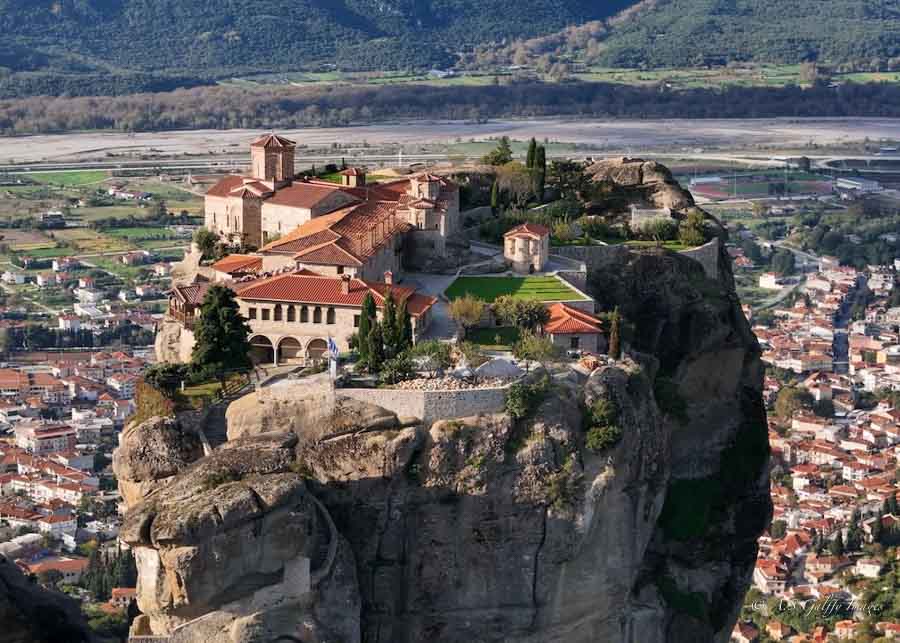
The monastery, which was founded by a monk in 1476, is carved into a rocky precipice. Like most other monasteries in Meteora, the only access was via a rope-ladder and the traditional net. That was until 1925 when 140 steps were carved into the rock.
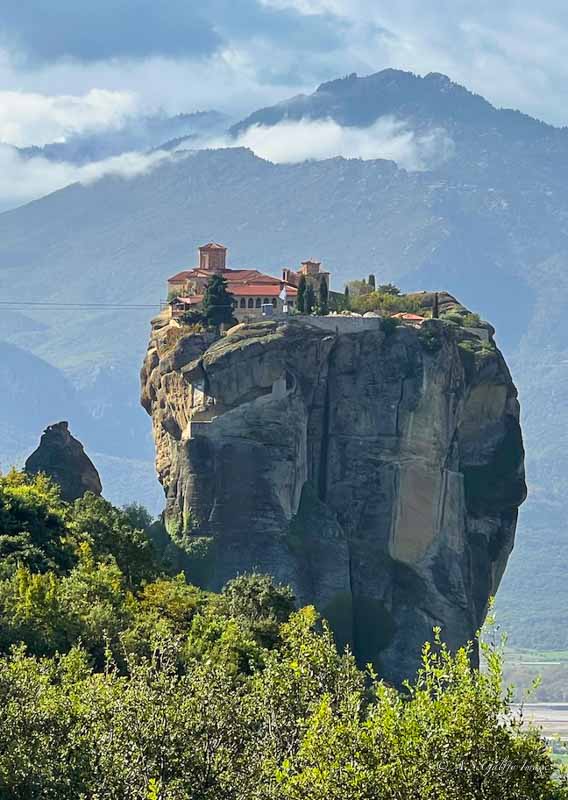
The interior contains outstanding frescos, especially in the chapel of St. John the Baptist, a small circular church hewed on the rock. The monastery had many valuable relics, such as crosses, priestly vestments, old codices, manuscripts, and sacred vessels. Unfortunately, during the German occupation the monastery was looted many times and even the monastery bell was stolen.
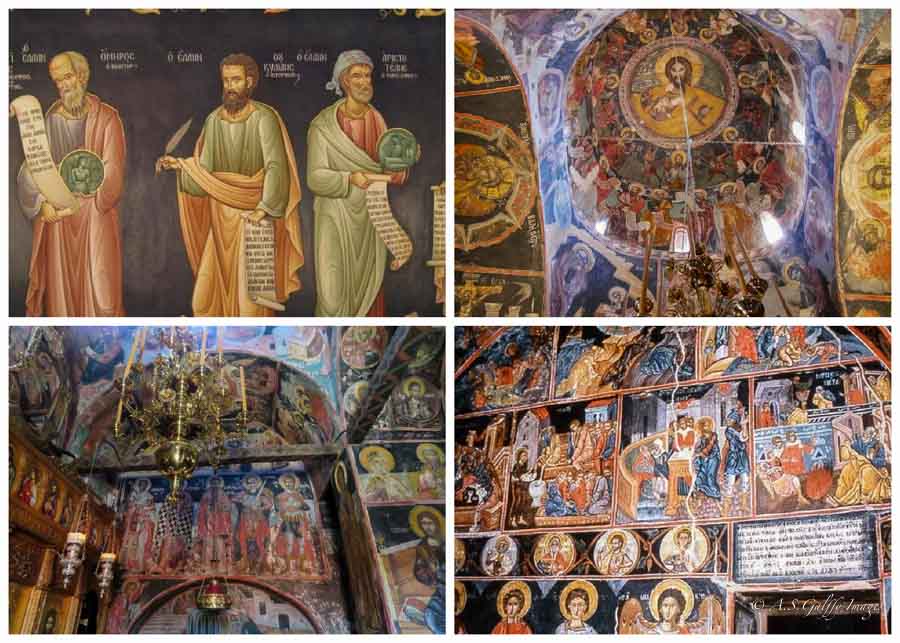
Sadly, only 26 old icons about 120 manuscripts have been preserved. These manuscripts are in the custody of Agios Stefanos Monastery, for safety reasons.
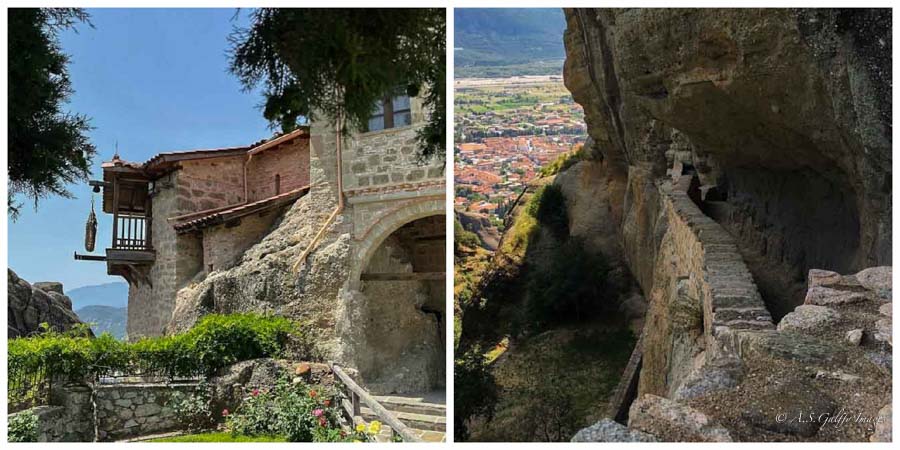
Of all the Meteora Monasteries, the Holy Trinity is the one with the most walking, assuming you arrive here by car or by bus. From the main road, there is a paved walk downhill about a few hundred meters long, followed by 180 steep steps to the entrance.
Agios Nikolaos Anapafsa Monastery
Built in the 16th century at the initiative of Dionysius, who was the Abbot of Larissa Town, Agios Nikolaos Anapafsa Monastery is the first on the way to Meteora. The monastery probably served to the pilgrims as a resting place before continuing on. Hence its name Anapafsa, which in Greek means “the one who rests.”
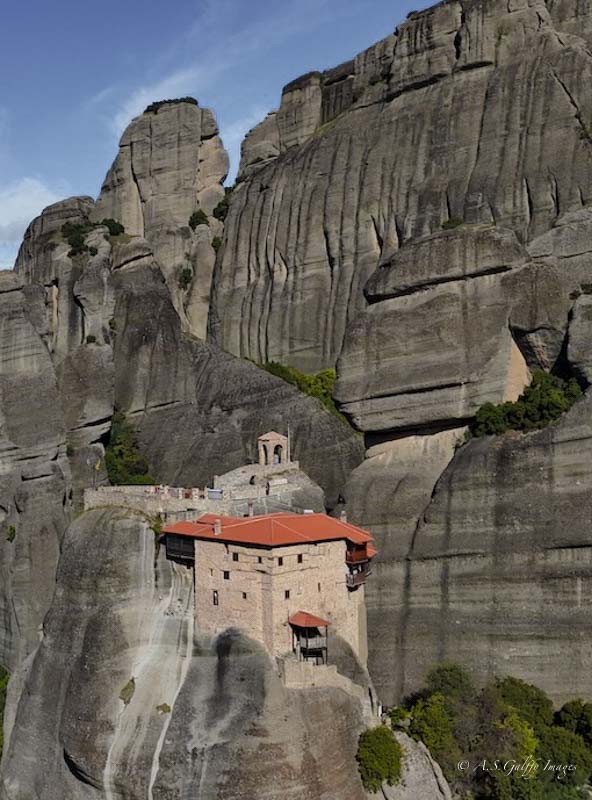
Because the surface of the rock on which it sits is very small, the monastery was built vertically, on more levels. Access to the different floors is done through an inbuilt staircase.
The main church of Agios Nikolaos Anapafsa is famous for its well-preserved wall paintings, made by the renowned painter Theophanis of Crete, also known as El Greco. Despite this, at the beginning of the 20th century the monastery was abandoned and began to decay. But in the 1960s, the Archeological society of Greece renovated and restored it.
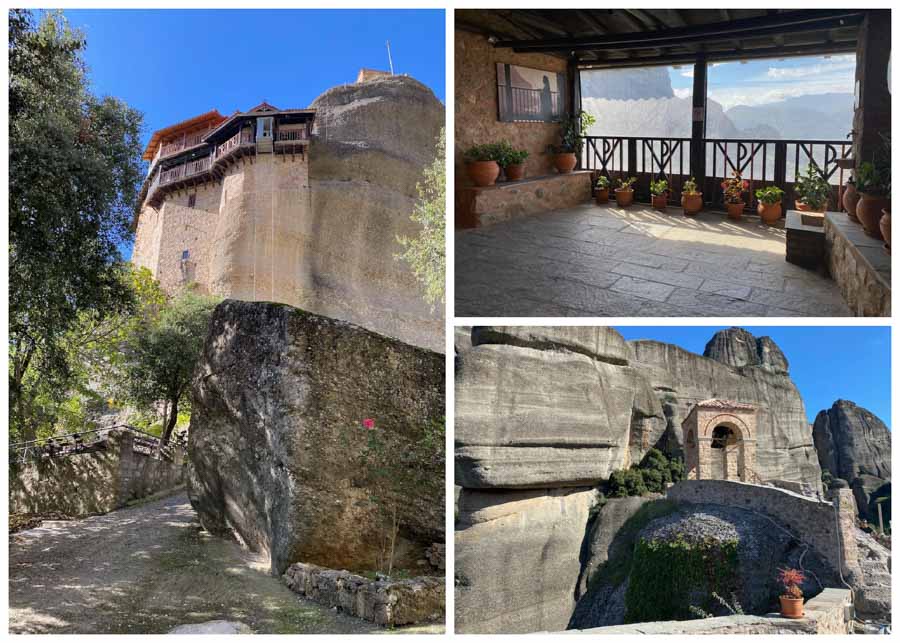
The road leading up to the monastery passes through a beautiful forest, then climbs up through a set of stairs carved in the rock. Although it is the lowest of the six monasteries, it still provides great views and backdrops.
Other Places to Visit Around Meteora
Agios Georgios Mandilas Cave
Perhaps the most popular local cave in Meteora is the one dedicated to St. George, located high up on a vertical rock, just outside the village of Kastraki. Because of the many colorful scarves inside, the locals call it “Agios Georgios Mandilas,” which in translation means St. George with the Scarves.
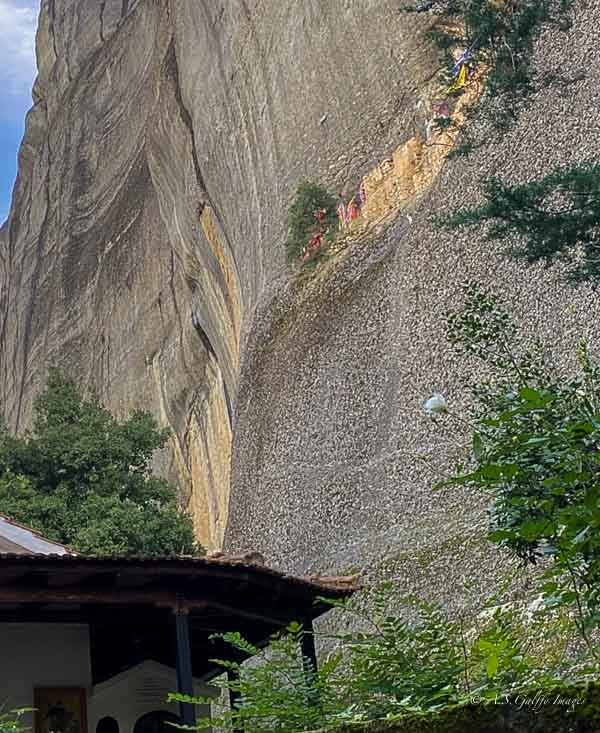
The story says that a Muslim man from the nearby village suffered a deadly injury as he was chopping down a tree. Advised by the villagers and desperate to save her husband, his wife began praying to St. George for a miracle.
Soon after that the man recovered completely, so his wife was convinced that St. George responded to her prayers. In gratitude, the Muslim woman removed her headscarf and placed it below the cave. And so a new tradition was born.
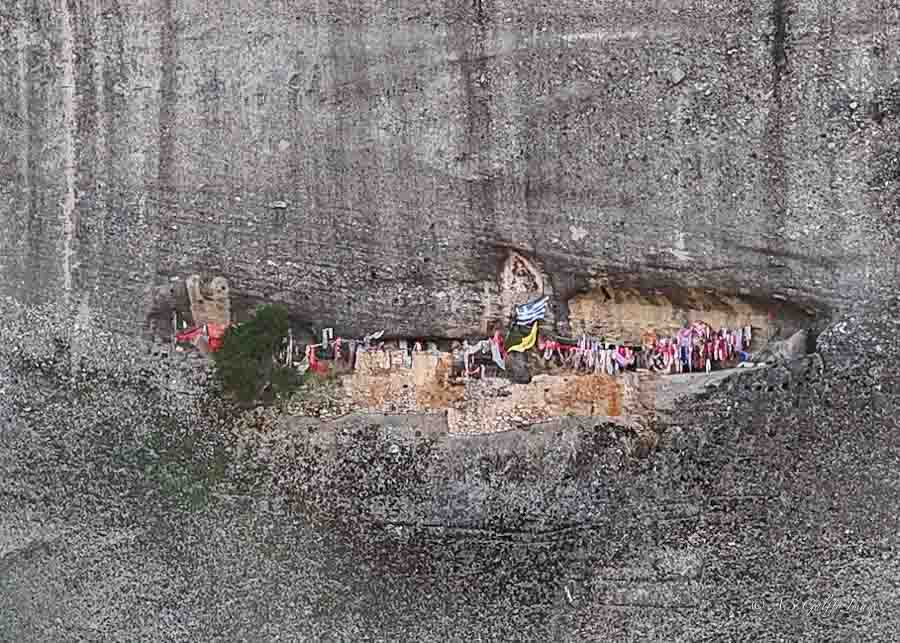
Since then, every year young men from the village climb up to the cave and bring with them a bunch of scarves that were left at the base of the rock by the village women. When they descend, they bring down with them the ones that were brought up the previous year. People believe that the scarves that stayed in the cave have been sanctified. So they gathered around the climbers trying to grab at least a small piece of a scarf that will help them to stay in good health throughout the year.
The Byzantine Church of Panagia
Not many people coming to visit Meteora are aware about the existence of this interesting church. Located in the old town of Kalambaka, the Church of the Assumption of Virgin Mary, as it is also called, is an important monument of the Byzantine period.
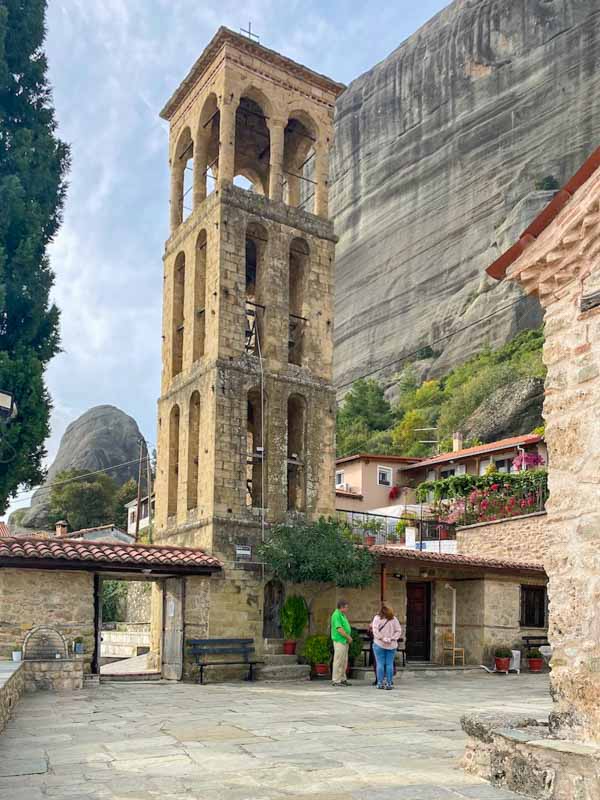
The current structure was erected between the 10th and 11th century on the ruins of an early Christian basilica from the 4th century, which in its turn was also erected upon an Ancient Greek Temple of Apollo. The structure is a three-aisled basilica with an elevated middle aisle.
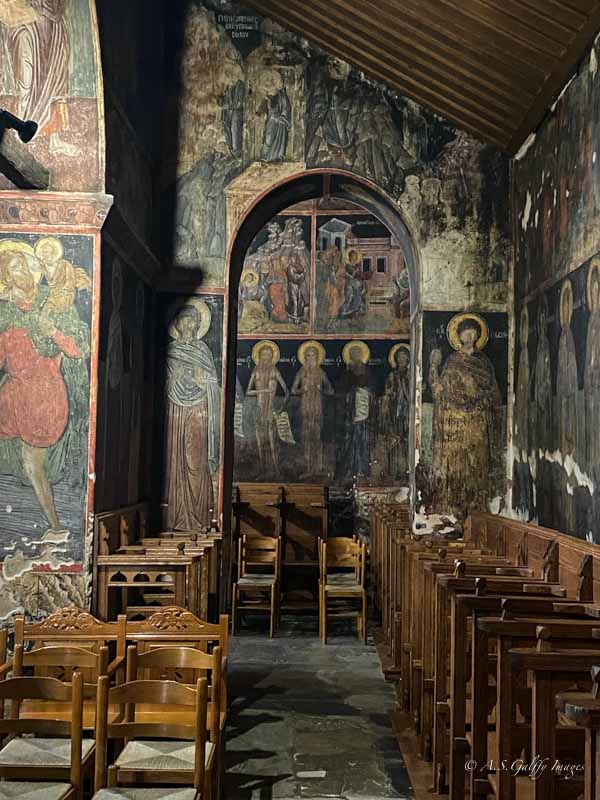
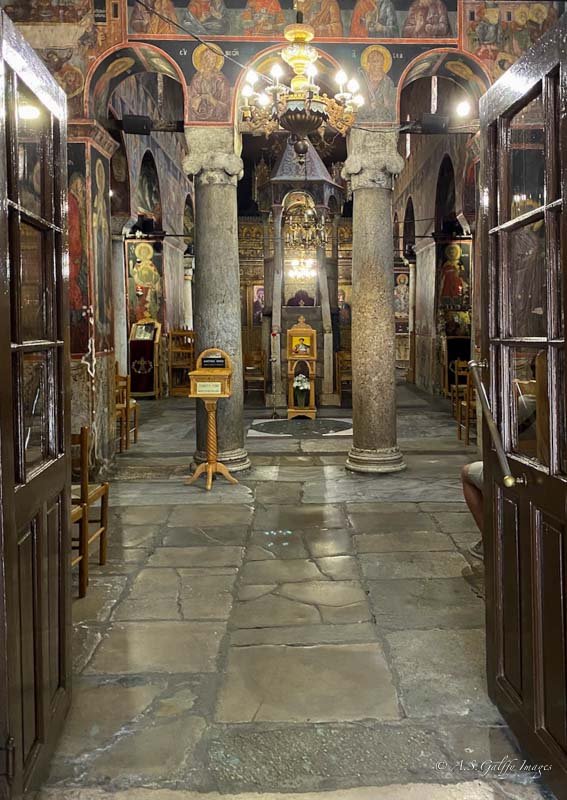
The amazing frescoes inside are a match for any murals you’ll see in the Meteora Monasteries! They have been painted between the 12th to 16th century by renowned iconographers. Among them is also Neofytos, the son of Theofanis from Crete (also known as El Greco).
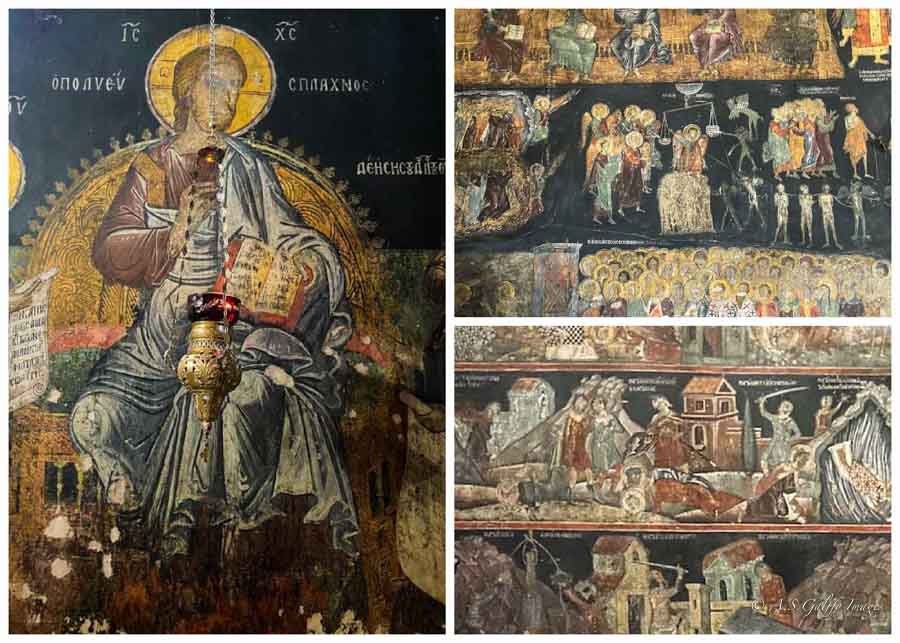
On the southern wall of the church you’ll see some built-in marble sculptures from the pagan Temple, as well as from the early Christian Temple.
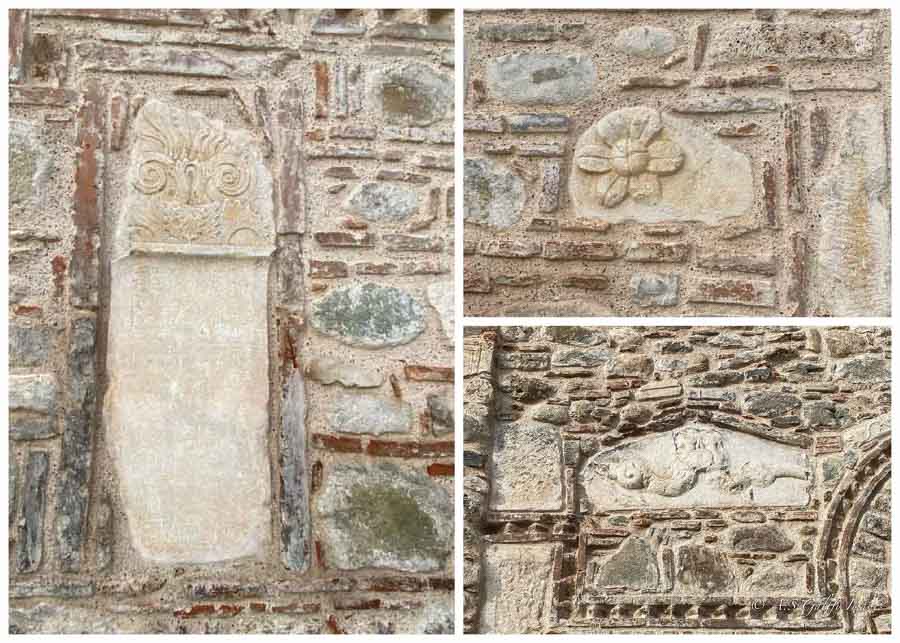
But perhaps the most impressive is the marble Pulpit standing in the middle of the nave. This is the world’s only Orthodox church that has a free-standing pulpit at its center.
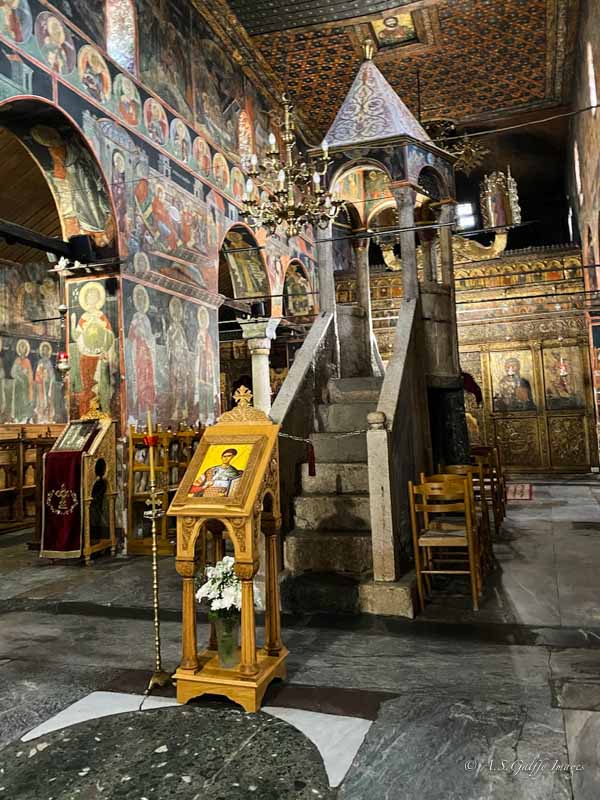
Interesting Facts About Meteora Monasteries
- For a very long time, the monks at Meteora accessed the monasteries by climbing up long ladders or by using large nets pulled by ropes. They also used nets and baskets o hoist goods up to the monasteries.
- Until 1955, there was no running water in the monasteries or Meteora. So for 615 years the monks had to rely on rainwater, or carry water from the river on mules.
- Many movie productions used Meteora as a filming location. But the one that made the monasteries known to the outside world was the James Bond movie, For Your Eyes Only, filmed in 1981.
- Women could not enter the Monasteries of Meteora until 1920, when they were allowed inside only because they came to help put out a fire!
- In 1921 Queen Marie of Romania visited Meteora, thus becoming the first woman to ever enter the Great Meteoron Monastery. By then the monks had already cut steps on the side of the rocks. They also built a bridge from the nearby plateau.
- During World War II, the Germans occupied Meteora and stole many of the precious artifacts. In Grand Meteora you can see images of people throwing a Nazi off a cliff from a monastery.
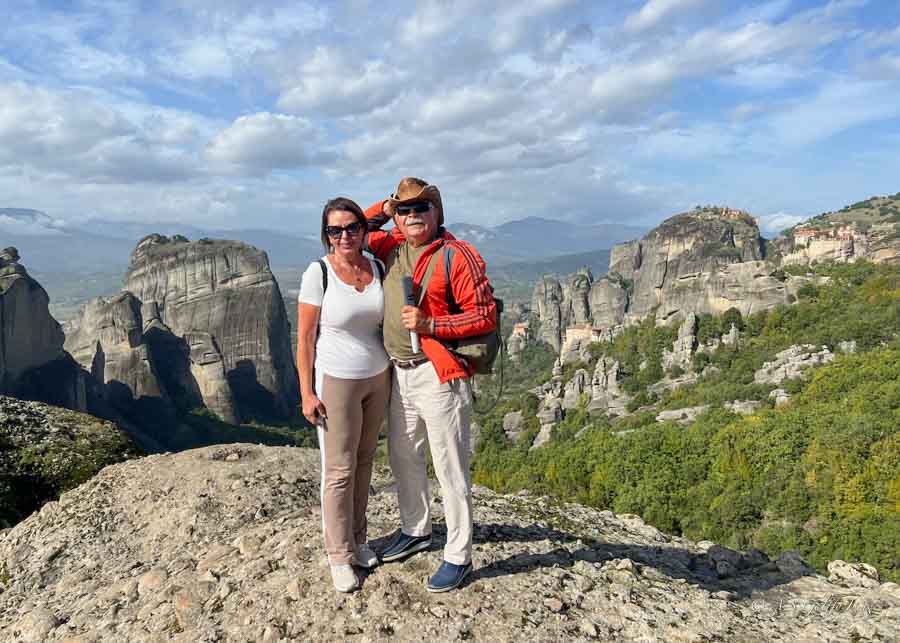
Useful Information for Visiting the Monasteries of Meteora
- All monasteries charge a small entrance fee of 3€ /person (children 12 and under enter free)
- Filming or photographing the interiors of the churches or the murals inside the monasteries is prohibited. You can however take pictures outside, in the courtyards.
- There is a strict dress code for the monasteries. Women have to wear a long skirt and cover their shoulders. Men have to wear long pants. Some monasteries provide skirts for a cost at the entrance.
- It’s difficult to “beat” the tour busses (but not impossible) – Most monasteries open at 9:30 am and busses arrive around 10 am. If you are at the gate a few minutes before the opening time, you’ll be able to visit at least two monasteries before the masses arrive.
- With the exception of Agios Stefanos, all the other monasteries in Meteora involve a lot of stair climbing. The steps leading to the monasteries can be slippery, so wearing comfortable walking shoes with good traction is important.
- Each monastery in Meteora closes on a different day of the week. Therefore, you should plan your visit around their schedule which you can check here.
- Many people choose to visit Meteora as a day trip from Athens, or from other big cities in Greece. If you plan to do that, there is a great day trip from Athens to Meteora by train which I can recommend. But if you want to visit all six monasteries you’ll need two full days in Meteora.
- You can easily visit the monasteries on your own, but before you do that I strongly encourage you to take at least a half day tour of Meteora. These tours provide lots of information about the site which will be very useful for your visit.
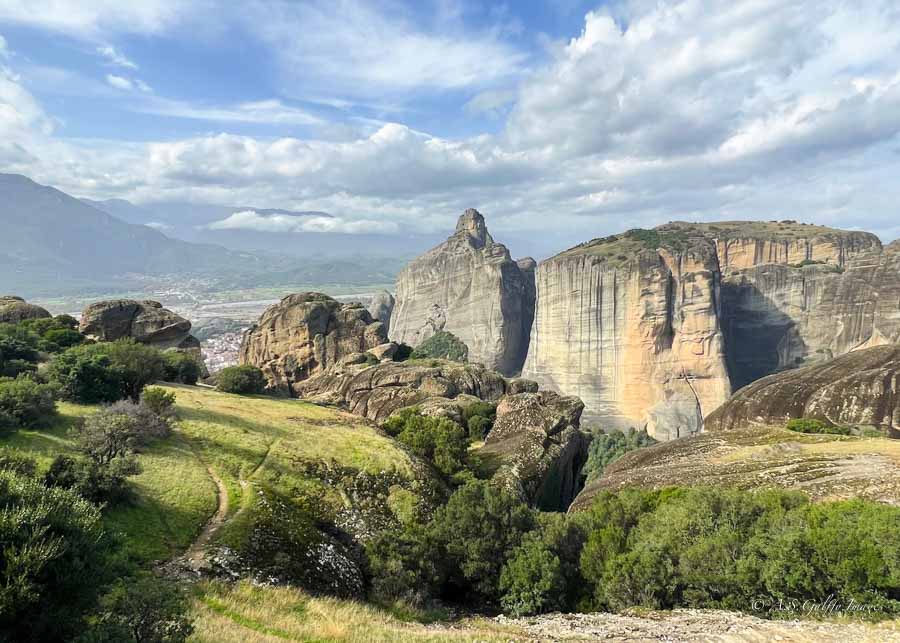
Where to Stay When You Visit Meteora
The two towns closest to Meteora are Kastraki and Kalambaka, so most people who visit the monasteries will stay in one of these two places. As a result, you’ll find plenty of hotels, guesthouses and tourist facilities, from which to access to the monasteries by car, bus, tour shuttles, or taxi. There are also plenty of hiking trails that lead up to the monasteries, if you are up to it.
We stayed at Oikia Guesthouse, which is a little outside downtown Kalambaka, on the border with Kastraki. We were very happy with our lodging facilities! The main advantage of this place is the location: within walking distance from shops and restaurants, yet in a quiet place on the road to the monasteries.
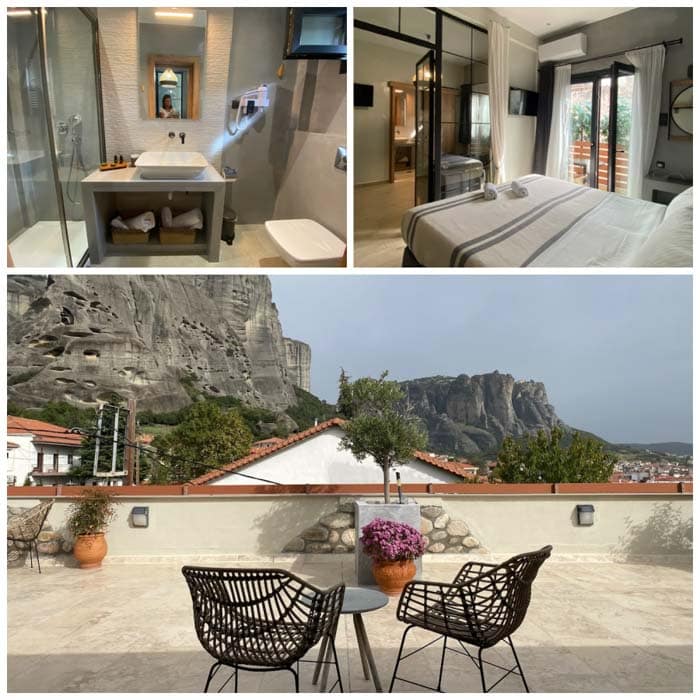
The tiny hotel which has been recently renovated, features rooms with balconies, junior suites, and standard rooms. But perhaps the most impressive feature of this guesthouse is the huge terrace at the top. From up there you can see the the rock formations of Meteora and the beautiful town below.
There are of course hotels for any taste and budget, like Divani Meteora, Archontiko Mesohori, or Tsikeli Boutique Hotel. So, if you are planning to visit to the Monasteries of Meteora, you can check hotel prices here.
READ NEXT: 2 Weeks in Greece – the Ultimate Peloponnese Road Trip Itinerary
Best Time to Visit Meteora
Meteora is a year-round destination and can be beautiful at any time of year. Even in winter. But if you come in summer, expect to walk shoulder to shoulder (literally!) with hundreds of other tourists. The best time to visit Meteora is in spring (April-May) or fall (October to mid-November). After November the weather changes dramatically and you can get a lot of fog.
That being said, keep in mind that weather can be very moody in this part of Greece, so clouds and even some rain may appear at any time. Especially if you visit off season. Even so, I’d rather take a chance with the atmospheric conditions than wait in line for two hours on the road up to the monasteries!
A Final Word
Spiritual experiences come in many forms, from the religious and intellectual, to those centered in art and nature. In centuries past, these monasteries were places of worship and spiritual retreats. They brought the monks not only solitude, but also protection from unwanted trespassers.
Today however, the Orthodox Monasteries of Meteora are one of the most popular destinations in all of Greece. With over 2,000,000 visitors a year, it’s pretty difficult to find peace and tranquility in this place. So one question still remains: is the popularity of these monasteries defeating the very purpose for which they have been created?
If you found this information useful, please pin it to help others discover this unique place!
